Making
Elemental Potassium (K)
I
recently began a new hobby; collecting elements. Of course
with
such a hobby comes a lot of chemistry. Especially due to the fact that
whatever elements I can isolate by myself, I will. I believe it is much
more fulfilling and educational to isolate an element yourself than
just
purchase it from some online retailer in a little vial or ampoule. Of
course with chemistry there is inherent danger. So this disclaimer is
necessary:
Disclaimer:
All experiments in this text should be done outside or in a fume hood
with proper lab and safety equipment. It must be done by or under the
direct supervision of someone experienced with chemistry laboratory
procedures. These procedures must never be done in the presence of
young children or animals.
First I want to thank the many contributors on
ScienceMadness, as
their procedures and successes are what helped me achieve success with
this reaction. Credit is also owed to the author of the thread at
http://www.versuchschemie.de/topic,14677,-Synthese+von+Kalium.html.
I performed this reaction 5 times without success. My
6th and 7th attempts were successful. What I determined caused failure
in reactions 1-5 was the use of impure (95%) magnesium.
Be sure to check out my latest and most successful attempt at isolating elemental Potasisum here: (Revisited) Making Elemental Potassium (K)
So
here is the outline I wrote myself for the procedure:
The
reactants were as follows:
- 2g
high purity Mg. approx 75 mesh, very low oxide. ( I actually made this
immediately before the reaction from a high purity ingot) You can
produce this with a medium metal file or as I did using a milling
machine to produce very fine turnings. My source for the magnesium was
an Amazon seller named GalliumSource who sells small 99.9% pure
magnesium ingots. I highly recommend using Magnesium of this purity, as
lower puritys I tested did not produce success. Magnesium
Metal Ingot, 99.95% Pure, 8 Ounces

- 0.8mL
t-Butyl alcohol. t-Amyl can also be used with even greater success. This acts as the catalyst in
the
reaction and is somewhat difficult to find but can sometimes pop up on eBay.
- 35mL
ultra pure paraffin
oil. Tetralin
is also reported to
work excellent but I was unable to obtain it. Due to Tetralins density
being
higher than potassium, the potassium coalesces into large balls on the
surface. Decalin can also be used with the same benefits of Tetralin.
Some other solvents reported to work are hypoallergenic baby
oil, medium kerosene lamp oil, mineral oil should work just fine, and
of course Shellsol D70, which is what was originally used as the
solvent for this reaction.
I
used a 50ml boiling flask, and a 200mm west condenser for reflux. I set
my hot
plate to 270*C and used a sand bath to heat the flask. A balloon with a
small
hole poked in it was fixed to the top of the condenser to minimize
atmosphere
from entering. Here is a picture of the setup:
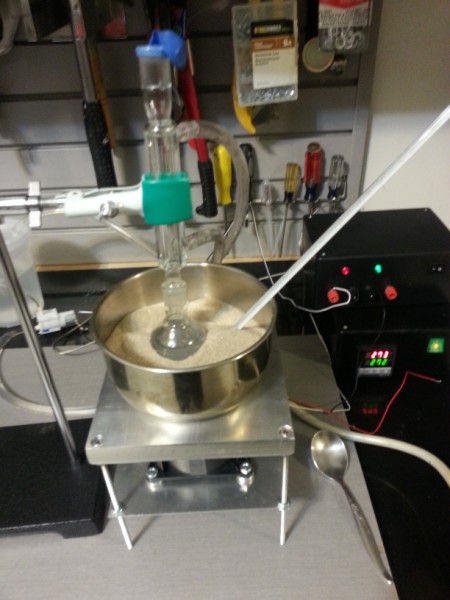
First
the Mg was added to the flask, then
the KOH. The 35mL of
paraffin was then added, and heated in the sand bath to drive off all
water
within the KOH due to its hygroscopic nature.
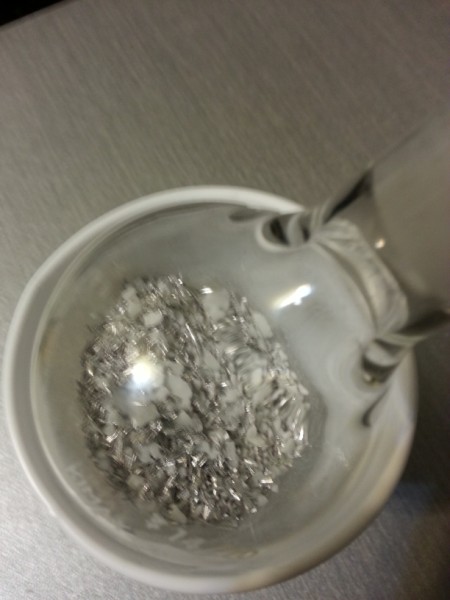
Note: The picture above shows the
reactants from one
of my first procedures (unsuccessful). The Magnesium
was only 95% pure which impeded the reaction, and the particle size of
the both Mg and KOH was too large.
The Mg helps speed the
displacement of water forming some MgO. Hydrogen evolution was noted in
small
quantities. After 30 minutes of heating, the t-butyl was added in small
.1mL
increments over the course of 2 hours. This was added by injecting
through the
balloon using a pipette to pierce the balloon and minimize atmospheric
contamination. After 3 hours small globules of potassium were noted as
seen below.
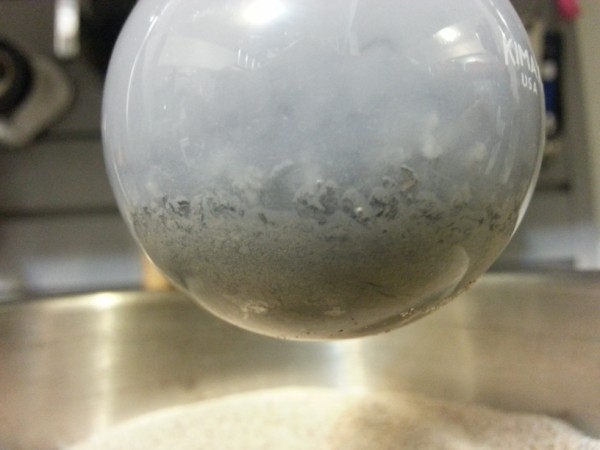
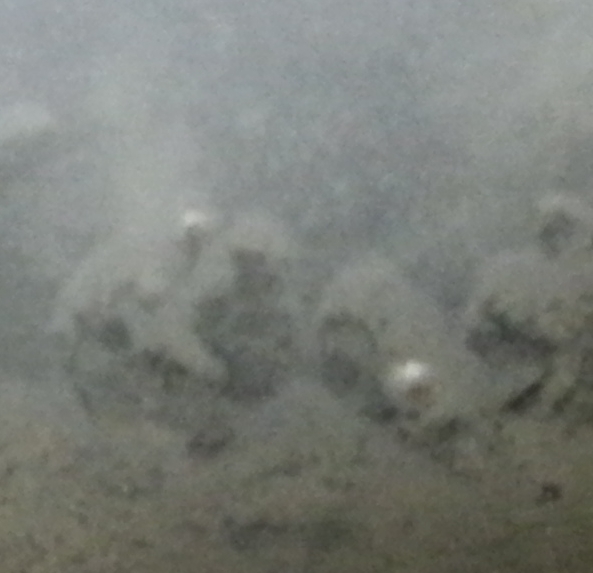
After 6
hours of reflux, the experiment was stopped, and allowed to cool. After
cooling
the reaction products were dumped into a large watch glass, and the
potassium
balls were extracted and stored under paraffin oil.
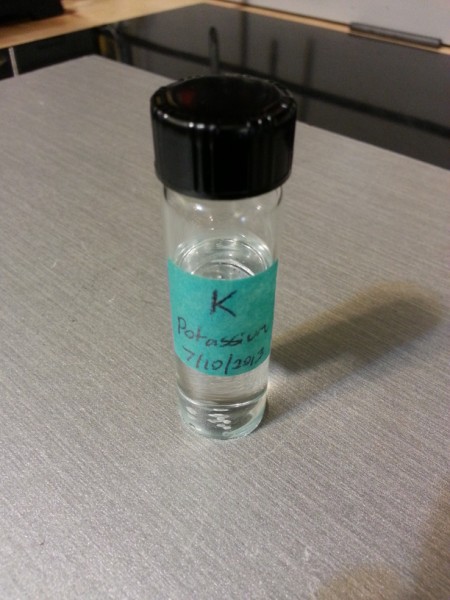
Final
yield was very poor due to my not allowing the reaction to progress
further upon
which the potassium would have coalesced much more, but my time was
limited.
But I can now add potassium to my element collection!
Some
Potentially
Helpful Notes:
Here is how I prepare the Magnesium turnings. If you have a
milling machine save your elbows some exhaustion! Please not that the
Magnesium turnings must be protected from the atmosphere as soon as
possible after being produced. I store it in sealed glass vials
immediately after making it. I first secure the Mg ingot into my
milling machines vise. After that I cut out a wide slit in the bottom
of a cardboard water bottle tray and slid it over the exposed part of
the Mg ingot. After setup I simply began milling a few thousandths off
at a time very slowly to produce extremely fine turnings.
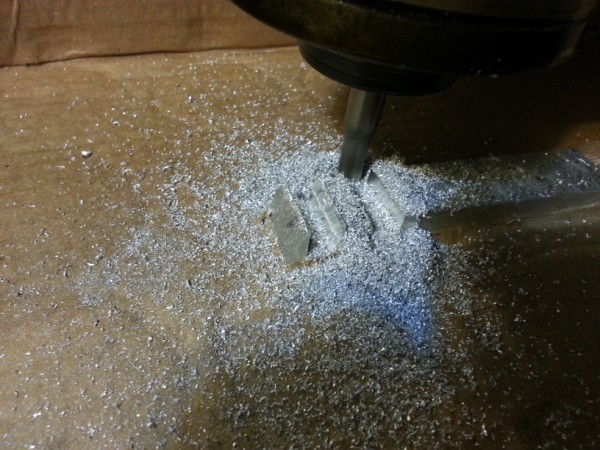
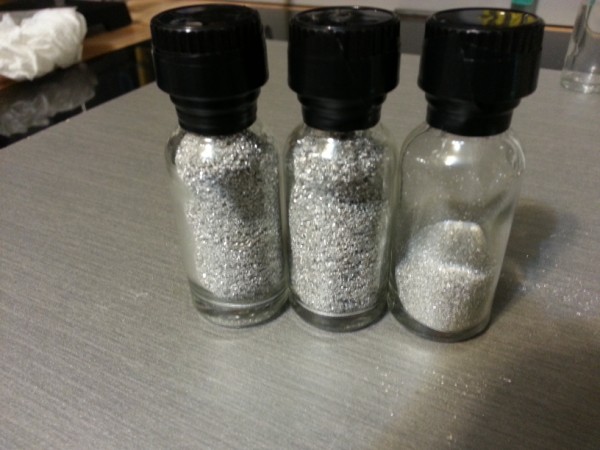
Solvents: It seems that certian solvents make this reaction occur with
better yield and faster reaction times. Using paraffin, mineral oil, or
a kerosene based solvent, the yield is approximately 50% at best, and
with long reaction times (~4+ hours). When using solvents such as
Shellsol D70, the reaction time is still long (~4 hours), but the yield
is greatly improved with many experimenters reporting yields greater
than 80%. Finally when Tetralin or Decalin are used, the reaction time
seems to speed up greatly, and the yield is also high much like with
Shellsol. Some report reaction times of approximately one hour using
Tetralin.
Conclusion:
Although my production of elemental Potassium was successful, the final
yield was very poor since my potassium refused to coalesce. This may be
sue to my solvent or another unknown factor in my experiment. I will
try to use different solvents in future replications of this synthesis
in order to determine which solvents are most effective to promote
potassium coalescence.






